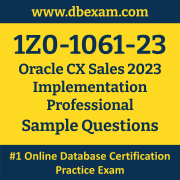01. The marketing analyst launched two promotions and is analyzing the responses. The source codes of several treatments are identical. What happened?
a) This is normal behavior. Source codes are based on the Combination of campaign, stage instance, and audience.
b) Source codes are defined by the end user in the Manage Multistage Campaign task.
c) This is normal behavior. Source codes are based on the combination of stage instance, audience and treatment.
d) Source codes in the Review Marketing Source Codes task were customized.
02. Which module maintains the industry hierarchy for territory definition?
a) Partner Management
b) Territory Management
c) Trading Management
d) Sales Quota Management
03. Before your company upgrades the production environment, it must go through an UAT process in an upgraded test environment.
Which three conditions must be met before the UAT can begin?
(Choose three.)
a) Defects are logged and prioritized
b) Sanity testing is complete
c) User sign-off has occurred
d) The production to test (P2T) content migration is complete
e) The test environment is stable and ready for testing
f) Test cases targeted for execution have been executed
04. Identify two activities that the Refresh Forecast process performs during a sales forecast.
(Choose two.)
a) It keeps future unfrozen forecast synchronized with the current opportunity data.
b) It updates the latest changes to the territory hierarchy.
c) It verifies that the opportunities are present with revenue line items, and notifies the user if the revenue line items are missing.
d) It keeps the forecast items that no longer meet forecast criteria.
e) It ensures that the forecasting schedule is generated and has the correct due date.
05. Identify an important prerequisite check that you should perform before importing product groups by using File-Based Import.
a) whether all the product groups that are to be imported already exist in the production instance
b) whether all the required data values are configured and imported in the production instance
c) whether the Sales Cloud was customized to capture additional attributes and whether the customizations have already been migrated
d) whether all the products related to the products groups to be imported already exist in the production instance
06. Which action must be performed when a Sales Catalog is imported with errors because it was assigned to an incorrect product group?
a) Log out from the application and log in again.
b) Inactivate the Sales Catalog version and create a new one.
c) Request a rollback from the application support team.
d) Access the Sales Catalog options and erase it.
e) Delete the Sales Catalog from the production environment.
07. You are customizing the mapping between a lead and an opportunity in order to add custom fields. You copy the standard mapping and add appropriate fields to the new mapping that is created.
However, your changes are not successful. Why?
a) You should have modified the standard mapping itself instead of copying and creating a new one. Only one mapping is allowed.
b) You must set the "MKL_DIRECT_LEAD_TO_OPTY_MAPPING_NAME" profile to the name of your custom mapping.
c) You must modify the Business Process Flow "Copy Lead To Opportunity Map" to refer to your custom mapping.
d) You must modify the Object Workflow "Copy Lead To Opportunity Map" to refer to your custom mapping.
e) You need to raise a ticket to My Oracle Support to bounce the server.
08. A date has been scheduled for your Sales Cloud environment upgrade. Which step must be performed in order to confirm the upgrade?
a) Enter your name and contact information. Click Submit Request.
b) Sign in to My Services for the environment to be upgraded by specifying the data center on the Oracle Cloud Portal, and then clicking My Services.
c) Select Schedule Maintenance from the Actions menu in the service listing on the Dashboard page, and then choose Release 12 Upgrade.
d) Select Schedule Maintenance from the Actions menu in the service listing on the Dashboard page.
e) Select the scheduled maintenance that you want to confirm from the list. Click Edit, and then read and accept the Terms and Conditions.
f) Choose from an available upgrade date.
09. You have created your product group hierarchy, either directly in the UI or through filebased import. Now you want to publish, enable, and validate it.
Which three statements are correct?
(Choose three.)
a) Validate that the catalog appears in the consuming applications.
b) When you publish, the application will attempt to publish all product groups that are unlocked. If you don't want some groups to be published, then you must lock them.
c) After you publish your product groups, if they are not published properly, you can delete them and republish.
d) Enable the catalog by assigning the root node to the "Base" usage.
e) You must publish the root node of the hierarchy in order for it to be available in the Manage Product Group Usage.
10. When you are working in an active sandbox, which three actions can you perform?
(Choose three.)
a) Extend the underlying data model by creating custom objects and fields.
b) Create object workflows.
c) Generate artifacts to import and export data.
d) Exit or publish the sandbox.
e) Create custom subject areas to design reports in BI Composer and BI Answers by setting the profile option to ZCX_ENABLE_CSA_SANDBOX_Y_N = No.
 The Oracle CX Sales Implementation Professional (1Z0-1061-23) Sample Question Set is designed to help you prepare for the Oracle CX Sales 2023 Certified Implementation Professional (OCP) certification exam. To become familiar with the actual Oracle Certification exam environment, we suggest you try our Sample Oracle 1Z0-1061-23 Certification Practice Exam.
The Oracle CX Sales Implementation Professional (1Z0-1061-23) Sample Question Set is designed to help you prepare for the Oracle CX Sales 2023 Certified Implementation Professional (OCP) certification exam. To become familiar with the actual Oracle Certification exam environment, we suggest you try our Sample Oracle 1Z0-1061-23 Certification Practice Exam.